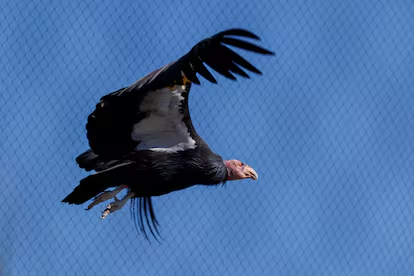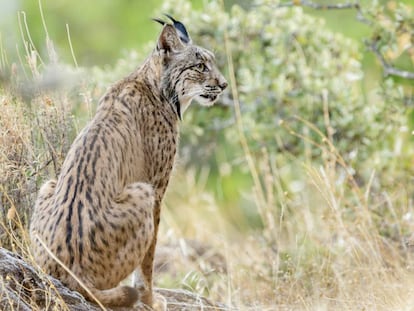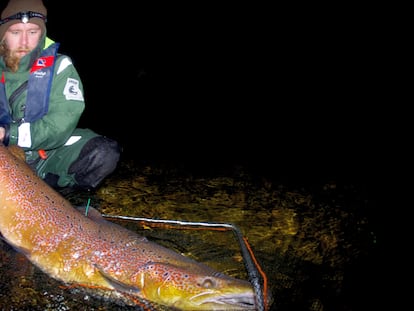Two critically endangered California condors produce chicks by ‘virgin birth’
This is the first case of asexual reproduction ever discovered in birds when breeding males were available

California condors have been in danger of extinction for decades, with their numbers reaching critical levels in the 1980s. Scientists at the San Diego Zoo Wildlife Alliance have been carrying out genetic studies for 30 years to determine the kinship between chicks and their progenitors. The researchers were amazed to find that two individuals had been born to different mothers without any genetic relation to a male being detected, meaning the chicks were biologically born without being fathered.
The genetic tests were repeated several times to eliminate the possibility of error and the conclusion reached was that the two chicks had been produced by parthenogenesis, a form of asexual reproduction also known as a “virgin birth.” What is striking about the discovery is that the two female condors, who were in captivity, were living with a breeding pool of male condors and had previously reproduced sexually. As such the discovery, which has been published in the American Genetic Association’s Journal of Heredity, represents the first known case of parthenogenesis in condors and the first among any avian species when the female had access to males capable of reproduction.
Cynthia Steiner, Associate Director in Conservation Genetics at the San Diego Zoo Wildlife Alliance and co-author of the study, defines parthenogenesis as “asexual reproduction in which the females can produce chicks without the contribution of a male. The eggs are not fertilized by a spermatozoon. There is a duplication of the female’s genetic material and it is she who contributes to produce the chick.”
It is important to differentiate between facultative and obligate parthenogenesis, which is present in many species – particularly among lizards – and in which the development of a new individual occurs exclusively without male contribution. The case of the California condors is facultative, as the female of the species usually reproduces sexually, but that on this occasion for reasons the scientists have not yet determined, occurred asexually. Jesús Gómez-Zurita, a scientist at the Botanical Institute of Barcelona who previously worked at the Catalonia-based Institute of Evolutionary Biology, describes the birth of the two condor chicks as “a biological error that should not happen,” pointing out that the genetics of the species itself contains “mechanisms” to prevent it.
The two chicks, both male, were born in different places and different years. The first, SB260, was born in the San Diego Zoo in 2001, while SB517 was born in the Los Angeles Zoo in 2009. Both died at a young age, given the average life expectancy of a California condor is around 60 years, according to Steiner. The first survived only two years after being released into the wild and failing to adapt; SB260 was a frail specimen, shorter and lighter than the average for his age. SB517 lived until he was almost eight years old and reached sexual maturity. He remained in captivity and the veterinarians responsible for his well-being noted that as well as being small, like SB260, he also suffered from scoliosis and was considerably more docile than male condors tend to be.
The parents of the two chicks had reproduced sexually with a pair of males before the birth of the parthenotes, the terms used to describe individuals born by parthenogenesis. Specifically, the mother of SB260 had 11 chicks by sexual reproduction, while SB517′s mother had 23 chicks by the same means, and later gave birth to two more.
According to data from late 2019, the total population of the California condor stands at 525 individuals: 219 in captivity and the remainder in the wild. Despite remaining on the critically endangered list, the species managed to avoid extinction in 1982, when there were only 22 birds remaining. This was achieved by preserving genetic variation through the mating of individuals who were not closely related. The US government ordered the capture of all remaining wild condors in 1987 and since the start of the breeding program in 1988, which led to the detection of the two parthenotes, more than 1,000 condor chicks have been born.
The dangers of parthenogenesis
Parthenogenesis has been recorded in 80 separate species since it was first discovered by Swiss naturalist Charles Bonnet in the mid-18th century. However, the conditions required for parthenogenesis to occur are not fully understood. Enrique Font is a professor at the University of Valencia, where he lectures on the subject of herpetology, a branch of the natural world whose animals are characterized by this type of reproduction. He explains that obligate parthenogenesis is associated with hybridization between a male and a female of different species and that the result “produces alterations that cause the female, from this single pairing, to become parthenogenic and produce a clone. In this way, a species is established that from that moment on does not contain males.” With regard to facultative parthenogenesis, which has been documented in four very diverse taxonomical groups – birds, sharks, lizards and snakes – Font says it has been proposed that it could be due to an adaptive nature or, in agreement with Gómez-Zurita, the result of an “aberration.”
This process of asexual reproduction could be utilized as an option to help boost the numbers of species that are in danger of extinction, but it would be very complicated to achieve because it is a naturally occurring process, these experts explain, and is therefore not considered practicable. Steiner suggests that it could be a mechanism to give rise to new populations when animals migrate to other regions. However, she stresses that parthenotes are characterized by a very low genetic variability, given that they carry two exact copies of the genes of the mother. “Nor is it completely beneficial for a population that all individuals are produced by parthenogenesis because there is a reduction in genetic variability,” which is a key element in “providing a cushion of resistance” against changes in the environment. Furthermore, in some animals, parthenogenetic females only produce male offspring, which would make the expansion of the species even more difficult as these would be unable to reproduce.
Tu suscripción se está usando en otro dispositivo
¿Quieres añadir otro usuario a tu suscripción?
Si continúas leyendo en este dispositivo, no se podrá leer en el otro.
FlechaTu suscripción se está usando en otro dispositivo y solo puedes acceder a EL PAÍS desde un dispositivo a la vez.
Si quieres compartir tu cuenta, cambia tu suscripción a la modalidad Premium, así podrás añadir otro usuario. Cada uno accederá con su propia cuenta de email, lo que os permitirá personalizar vuestra experiencia en EL PAÍS.
¿Tienes una suscripción de empresa? Accede aquí para contratar más cuentas.
En el caso de no saber quién está usando tu cuenta, te recomendamos cambiar tu contraseña aquí.
Si decides continuar compartiendo tu cuenta, este mensaje se mostrará en tu dispositivo y en el de la otra persona que está usando tu cuenta de forma indefinida, afectando a tu experiencia de lectura. Puedes consultar aquí los términos y condiciones de la suscripción digital.
More information
Archived In
Últimas noticias
There is as much life left to discover on planet Earth as that which is already known
Dozens presumed dead, around 100 injured in fire at Swiss Alps bar during New Year’s celebration
Is porn for women different from conventional porn? We spoke to those who make it
Cartagena de Indias is sinking: What can the city do to mitigate it?
Most viewed
- Reinhard Genzel, Nobel laureate in physics: ‘One-minute videos will never give you the truth’
- David King, chemist: ‘There are scientists studying how to cool the planet; nobody should stop these experiments from happening’
- Oona Chaplin: ‘I told James Cameron that I was living in a treehouse and starting a permaculture project with a friend’
- Sinaloa Cartel war is taking its toll on Los Chapitos
- The Interoceanic Train, the Mexican alternative to the Panama Canal











































